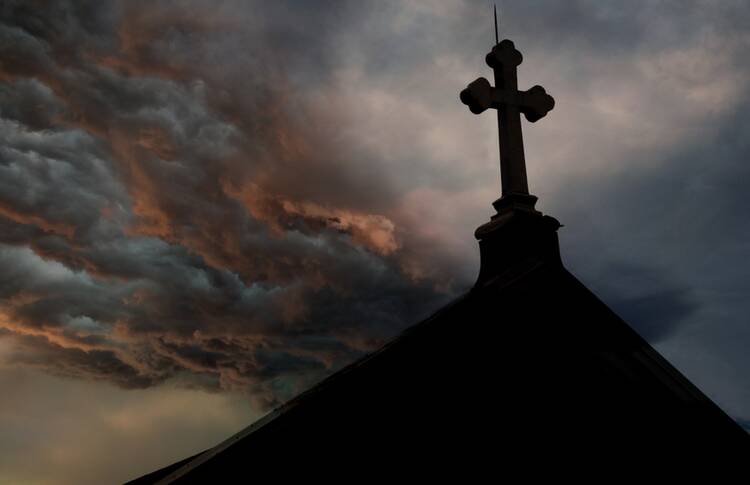Nearly three years after a searing report issued by a Pennsylvania grand jury detailed the sexual abuse by clergy of thousands of children and the extensive cover-up by church leaders that followed, America asked the Center for Applied Research in the Apostolate at Georgetown University to survey Catholics nationwide about their understanding of the crisis, its emotional impact and how it has affected their faith.
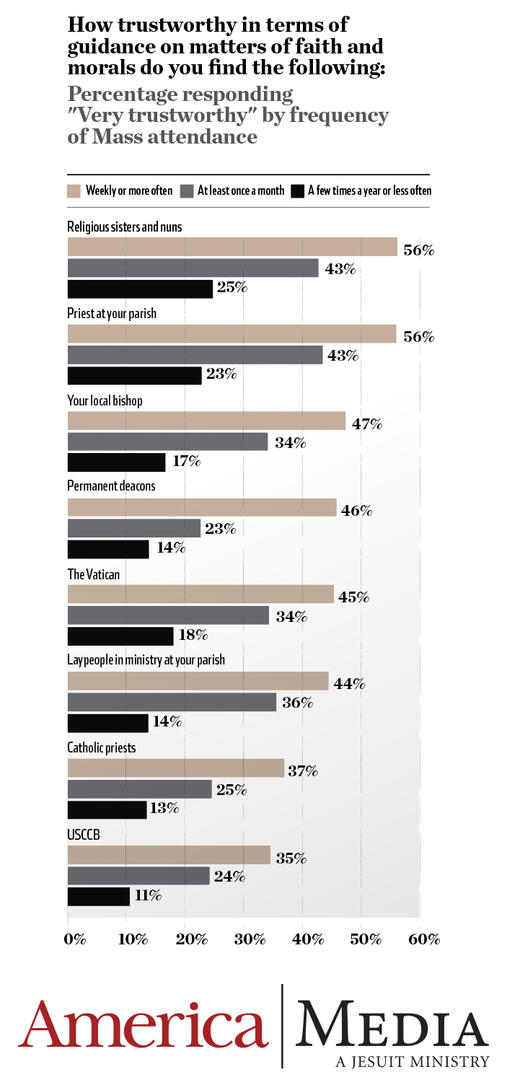
CARA asked respondents other questions about their faith, including about the effects of the Covid-19 pandemic on Mass attendance. It also asked about financial contributions to the church, as well as the controversy over whether Catholic politicians who support legal abortion should be denied Communion. In September America will explore these and some of the other issues reviewed in the survey, including the blessing of same-sex relationships, women’s ordination and more.
Fifty-seven percent of the Catholics surveyed by CARA said they pay “a great deal” or “quite a bit” of attention to the issue of the sexual abuse of minors by clergy, similar to the 56 percent who said the same in a survey conducted by CARA in 2007. Fifty-one percent of adult Catholics said that they believed Pope Francis has at least “sufficiently” handled the crisis.
Forty-five percent of adult Catholics said the issue of sexual abuse has hurt the overall reputation of the church “a great deal.” Thirty-one percent said it has damaged this reputation “somewhat.” Twelve percent said it has hurt the reputation of the church “only a little.” Five percent said it has hurt the reputation of the church “not at all.” Six percent said they “don’t know.”
Asked to evaluate the trustworthiness of people working in the church, respondents were most favorable toward religious sisters and nuns—75 percent considered them “very” or “somewhat” trustworthy.
Thirty-four percent of adult Catholics said the sexual abuse crisis has affected their willingness to speak positively about faith and Catholicism outside of church circles. Thirty-one percent said the crisis has made them “embarrassed” to tell others that they are Catholic. At the same time, seven in 10 Catholics agreed “somewhat” or “strongly” that they are “proud” to be Catholic.
The retention rate for membership in the Catholic Church in the United States has been in decline in recent decades. In 2016, the General Social Survey, conducted nationwide, found that 69 percent of Hispanics and 63 percent of non-Hispanic white people who had been raised Catholic still identified as Catholic as adults. (Other CARA research has found that both the retention rate and the level of “confidence” in the church has declined more precipitously among low-income households; see “The church is losing touch with working-class Catholics,” America, November 2020.)
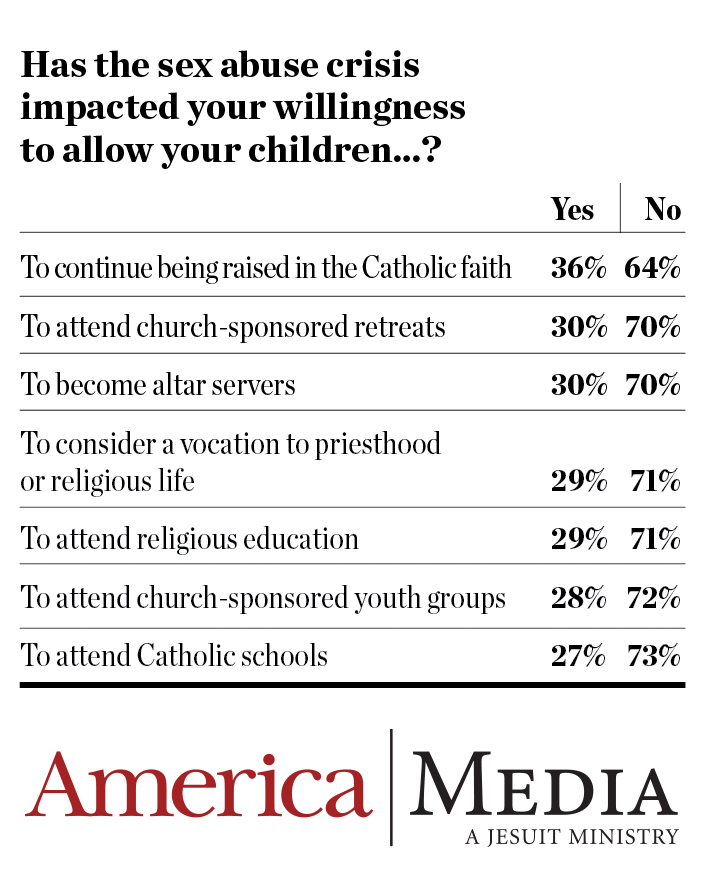
Many leave the church in their teens and early 20s. We know some who leave eventually return to the faith at a later age. Eighteen percent of adult Catholics have left the Catholic Church for a time at some point in their lives before returning to the faith. Only 4 percent of that group, given the opportunity to answer however they wished, said they left because of the abuse crisis, although an additional 17 percent cited more general reasons like “distrust,” “disillusionment” and “disappointment” with the church.
Respondents were asked what they believed to be the main causes of the sexual abuse crisis. The most common response to the question, by 23 percent of respondents, was “don’t know” or “have no idea.” The second most common response, including 22 percent of comments, referred to celibacy, sexual abstinence and the inability of priests to marry as a cause of the crisis.
Eighteen percent of comments found fault with the institutional church and its leadership. Some of the responses in this category referred to failures in screening candidates or fault seminaries. Others criticized the church for seeking to keep allegations secret.
Thirty-one percent said the crisis has made them “embarrassed” to tell others that they are Catholic.
Fifteen percent of the respondents’ comments placed the blame on priests themselves, described variously as “deviants,” “flawed human beings,” “the abuser is out of his mind” or “individual degenerates.”
Three percent of responses suggested homosexuality as a cause. And 3 percent suggested that the trust placed in priests and leaving children alone with them created a situation where abuse became possible.
Twenty-one percent of adult Catholics said the news media’s coverage of accusations of sexual abuse of minors by clergy has been “excessive.” A majority, 57 percent, said the coverage has been “about right.” Twenty-two percent consider it to be “insufficient.”
Misconceptions About the Crisis
In 2007 and again this year, CARA asked a series of questions to gauge Catholics’ understanding of the scope of allegations. Few adult Catholics understand these factual elements of the sexual abuse crisis, and some misconceptions have grown worse over time. Thirty-one percent of respondents in this year’s survey believed that Catholic priests are more likely than men in other professions that work with children to commit acts of sexual abuse. There is no evidence to support that conclusion. Twenty-four percent believed priests are less likely to do so and 45 percent believed both groups are equally likely to do so.
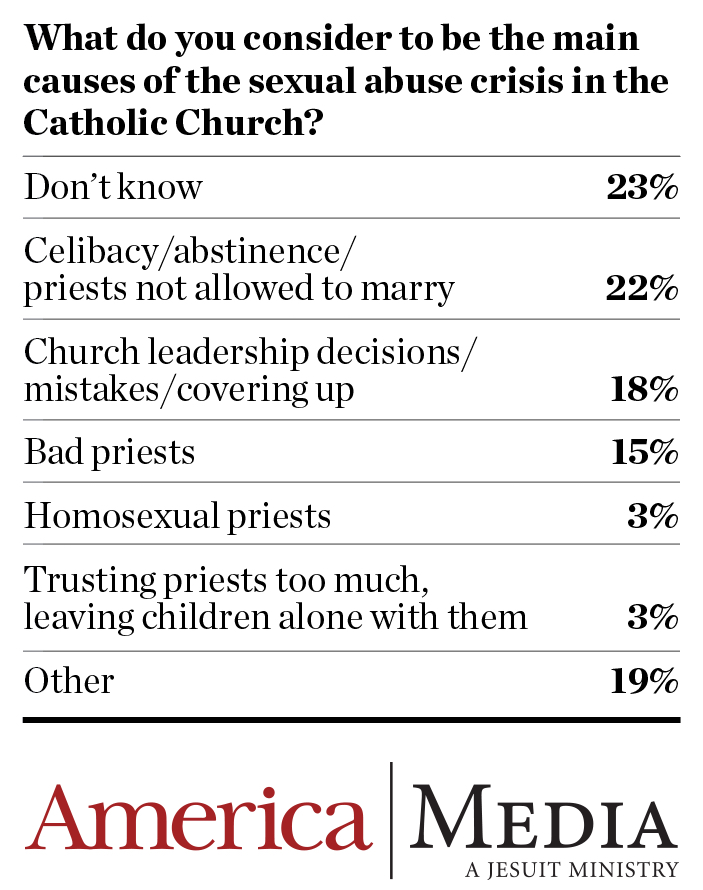
Since 2007, the share believing abuse is more likely among priests has increased by 16 percentage points. (A report completed in 2011 by the John Jay College of Criminal Justice, commissioned by the U.S.C.C.B., concluded that “sexual abuse in institutional settings, such as churches, schools, or child care facilities, is a serious and underestimated problem” but added that abuse by clergy has received more media attention in part because “No organization has undertaken a study of itself in the manner of the Catholic Church.”)
Twenty-one percent of adult Catholics said the news media’s coverage of accusations of sexual abuse of minors by clergy has been “excessive.” A majority, 57 percent, said the coverage has been “about right.”
Only 34 percent of respondents correctly said that fewer than 5 percent of priests since 1950 have had credible accusations of sexual abuse made against them. Thirty-seven percent incorrectly believed that the share has been 6 to 10 percent, and 29 percent incorrectly believed that it exceeds 10 percent. In 2007, the share who knew that fewer than 5 percent of priests have been credibly accused was 52 percent; this has since fallen by 18 percentage points.
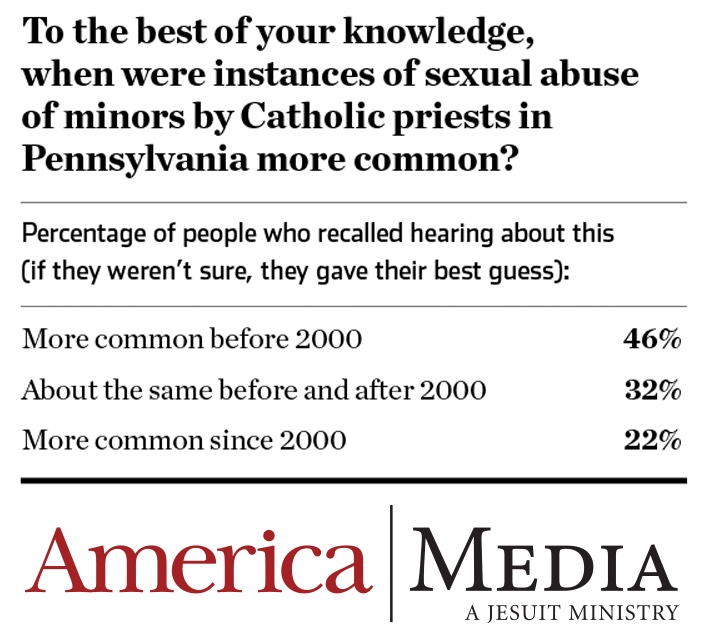
Thirty-three percent of respondents correctly believed that instances of sexual abuse of minors by Catholic priests were more common before 1985 than after. Thirty-six percent incorrectly believed that instances are about the same before and after 1985, and 30 percent incorrectly believed abuse has been more common since 1985. The percentage responding correctly has increased by only 3 percentage points since 2007.
Respondents were provided with the following text: “In August 2018, a Pennsylvania Grand Jury released a report detailing allegations that 301 clergy sexually abused more than 1,000 minors in six of the eight Catholic dioceses in the state over many decades.” Forty-seven percent indicated they recalled reading the report.
Men were more likely than women to recall the report (53 percent compared with 43 percent). Millennials (born 1982 or later) were among the most likely to recall the report (54 percent). Non-Hispanic Catholics were more likely than Hispanic Catholics to recall the grand jury findings (51 percent compared with 39 percent).
Forty-six percent of those who had heard about the Pennsylvania grand jury report were able to correctly respond that the instances of sexual abuse described there were more common before 2000. Thirty-two percent incorrectly responded that the incidence of abuse before 2000 was about the same as it has been since 2000. Twenty-two percent incorrectly believed the incidence of abuse was more common since 2000, suggesting that confusion continues about some aspects of the crisis.
Only 34 percent of respondents correctly said that fewer than 5 percent of priests since 1950 have had credible accusations of sexual abuse made against them.
There were 59 cases of clergy sexual abuse of minors reported nationally from 2015 to 2019 (approximately 12 accusations per year).
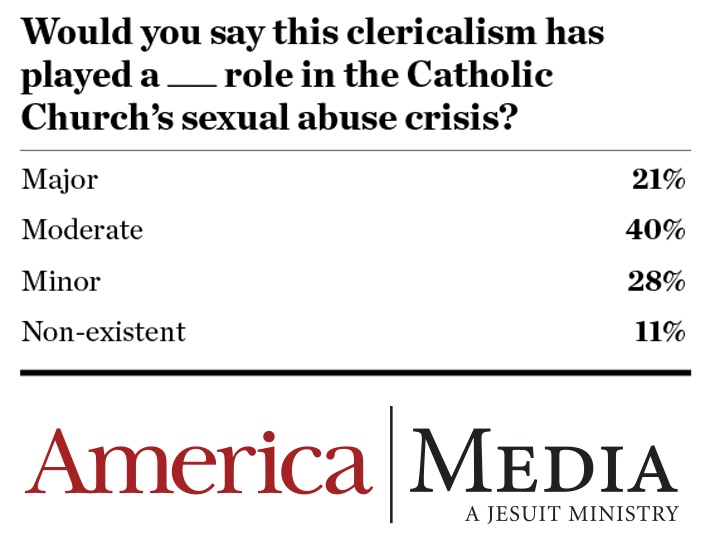
Among those who recalled the Pennsylvania cases, 44 percent said their perceptions about the progress the church has made in preventing abuse had changed. Forty-one percent said their perceptions became more negative and 59 percent said they were more positive.
Note again that the trends in the grand jury report suggest a large decline in the incidence of cases over time—especially after 2000. Thus, respondents aware of the details of the cases may have been reassured that the incidence of abuse had dropped off dramatically in more recent decades.
Nineteen percent of respondents believed sexual abuse of young people by Catholic priests happens “often” these days. Forty-four percent believed this happens “occasionally” and 33 percent “rarely.” Four percent believed this “never” happens.
Millennial respondents (born in 1982 or later) were more likely than older Catholics to believe abuse happens “often” these days. Twenty-three percent of these young Catholics responded as such, compared with 12 percent of Vatican II Catholics (born between 1943 and 1960) and 9 percent of pre-Vatican II Catholics (born before 1943). Post-Vatican II generation Catholics (born between 1961 and 1981) had a response similar to millennials (22 percent).
Sixty-nine percent of all respondents believed priests are sometimes falsely accused of abuse. Among those who believed priests are falsely accused sometimes, 14 percent believed “many” are falsely accused and 53 percent believed “some” are falsely accused. About one-third of this group believed “only a few” are falsely accused.
Nineteen percent of respondents believed sexual abuse of young people by Catholic priests happens “often” these days. Forty-four percent believed this happens “occasionally” and 33 percent “rarely.” Four percent believed this “never” happens.
The McCarrick Effect
Respondents were also asked if they had heard of former Cardinal Theodore McCarrick. Thirty-eight percent of respondents said they had heard of him. Men were more likely than women to have heard of him (48 percent compared with 31 percent).
All respondents were then provided with the following text: “In June 2017, the Archdiocese of New York learned of an allegation that Cardinal Theodore McCarrick had sexually abused a minor in the early 1970s. After the accusation was deemed credible, Pope Francis requested McCarrick’s resignation. As the announcement was made of a credible accusation more victims came forward accusing McCarrick of sexual abuse.”
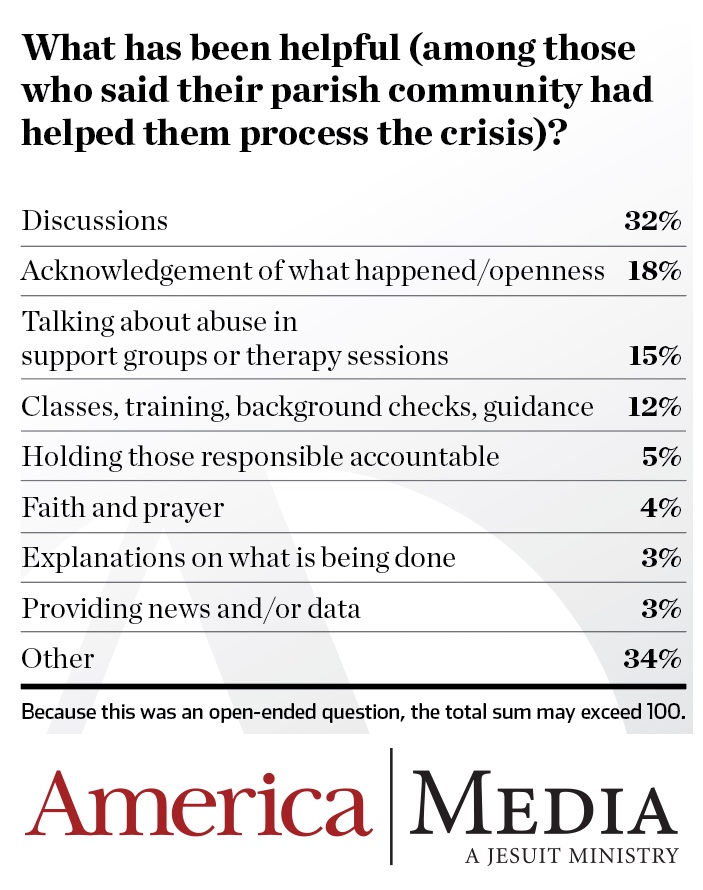
Forty-four percent of respondents indicated they did recall these allegations. Of those who had heard of the allegations, 50 percent said these changed their perceptions about the progress the Catholic Church has made in preventing abuse. Among those who had their perceptions changed by the allegations made against Mr. McCarrick, 48 percent said their perceptions became more negative, and 52 percent said they became more positive.
Fifteen percent of adult Catholics said they know someone who was sexually abused by a priest. Twenty-four percent have heard of a priest at their parish being accused of sexual abuse. Of those who had heard of a priest at their parish being accused, 47 percent said they believed this accusation was handled appropriately. Thirty-two percent said it was not handled appropriately, and 22 percent said they do not know how well it was handled.
Among those who heard of a priest being accused at their parish, 51 percent received this news from a local newspaper or television station, compared with 39 percent hearing about this at their parish, 24 percent on their diocesan website and 18 percent in their diocesan newspaper. Nine percent heard by some other means.
Using Pope Francis’ depiction of clericalism as an attitude in which “clerics feel superior” or “distance themselves from the people,” the respondents were asked if they believed it played a role in the church’s sexual abuse crisis. Twenty-one percent said clericalism played a “major” role and 40 percent a “moderate” role. Twenty-eight percent said clericalism played a “minor” role, and 11 percent said it had a “non-existent” role.
Fifteen percent of adult Catholics said they know someone who was sexually abused by a priest. Twenty-four percent have heard of a priest at their parish being accused of sexual abuse.
Asked to evaluate the trustworthiness of different types of people working in the church with regard to offering guidance on matters of faith and morals, respondents were most favorable toward religious sisters and nuns—75 percent considered them “very” or “somewhat” trustworthy. The U.S. Conference of Catholic Bishops finished the lowest among nine options on trustworthiness, but with a solid majority, 58 percent, still reporting that they consider the U.S. bishops to be at least somewhat trustworthy on these matters.
In the wake of abuse allegations, adult Catholics are most likely to believe religious sisters and nuns “need to have more influence” in the church. Forty-one percent said that bishops and cardinals need more influence, and 40 percent said laywomen need more influence in the church. Respondents were least likely to say that priests and religious brothers need more influence. Twenty-six percent said bishops and cardinals need “less influence,” and 23 percent said priests and religious brothers need less influence.
Parents’ Progress
Seven in 10 respondents were parents. Twenty-two percent of parent-respondents have children involved in activities or ministries at their parish. Eighteen percent said their child has asked them about the sexual abuse crisis. A third have initiated a conversation with their child or children about the sexual abuse crisis in the church.
Forty-seven percent have warned their child or children to be aware of the possibility that they or another child could become a victim of abuse in a parish setting. Twenty-two percent said staff at their parish have warned their child or children of the possibility of abuse.
Catholic parents are most likely to say the abuse crisis has affected their willingness to allow their children to: continue to be raised Catholic, 36 percent; to attend church-sponsored events, 30 percent; to become altar servers, 30 percent; to consider a vocation to priesthood or religious life, 29 percent; and to attend religious education, 29 percent.
Fifty-seven percent of the Catholics surveyed by CARA said they pay “a great deal” or “quite a bit” of attention to the issue of the sexual abuse of minors by clergy.
Thirty-six percent of adult Catholics said they have attended safe environment training at a Catholic school, parish or ministry. Eighty-four percent of those who attended these said that the training prepared them to help prevent or identify sexual abuse, and 90 percent said that the training helped make their school, parish or ministry a safer place for children.
Nearly half of weekly Mass attenders said they have heard the sexual abuse crisis discussed during a homily at Mass in their parish. Those who attend Mass less often were less likely to report hearing about it. Twenty-six percent of adult Catholics said their parish has formed a listening group in response to the sexual abuse crisis. Thirty-three percent said their parish community had helped them process the crisis.
Those who indicated their parish had helped them process the crisis were asked what their parish community had done. Discussions about the crisis outside Mass—mentioned in 32 percent of comments—was the most common response. Acknowledgments about what had happened and being open about the issue were cited in 18 percent of comments. Fifteen percent of comments cited talking about the crisis in support groups and therapy sessions, and 12 percent of comments referred to classes and training.
Returning to Normal Post-Pandemic?
With the country coming out of lockdowns and restrictions established because of the Covid-19 pandemic, self-reported Mass attendance is returning to normal. In late spring 2021, 21 percent of adult Catholics reported attending Mass at least weekly. This is the same share that reported attending Mass weekly in 2007.
Seven percent report still watching Mass on television or online because of the pandemic. Twenty-one percent attend Mass at least once a month and 26 percent a few times a year. Nearly a quarter rarely or never attend Mass. One percent report being unable to attend Mass because of their health or physical inability to attend.
With the country coming out of restrictions because of the Covid-19 pandemic, self-reported Mass attendance is returning to normal. In late spring 2021, 21 percent of adult Catholics reported attending Mass at least weekly.
Three-quarters of adult Catholics have already received a Covid-19 vaccine or plan to do so. Millennials are among the least likely to say they have gotten or plan to get a Covid-19 vaccine (60 percent). Catholic Republicans are just as likely as Democrats to say they have been vaccinated or plan to be (both at 76 percent). While 81 percent of those with a four-year college degree said they have been vaccinated or plan to be, only 69 percent of those with only a high school education, and 60 percent of those who have not completed high school, said the same.
Twenty-three percent said statements from U.S. bishops have influenced their decision to get a Covid-19 vaccine. Thirty-two percent of weekly Mass attenders said they were influenced by statements from U.S. bishops compared to 27 percent of monthly attenders and 16 percent of those who attend Mass a few times a year or less often. Seventeen percent said their stance on abortion has influenced their decision to get a Covid-19 vaccine.
This survey was conducted by the Center for Applied Research in the Apostolate at Georgetown University. CARA surveyed 1,050 self-identified Catholics from May 21 to June 4. The survey was taken online and was available in English and Spanish (861 respondents took the survey in English and 189 in Spanish). The sample was provided by the management and market research firm Qualtrics from actively managed, double-opt-in survey research panels.

